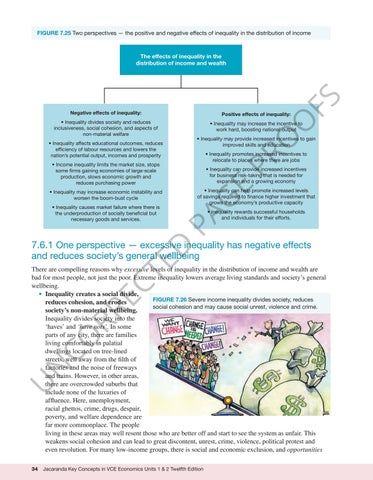“c07TheDistributionOfIncomeAndWealth_PrintPDF” — 2022/6/2 — 15:01 — page 34 — #34
FIGURE 7.25 Two perspectives — the positive and negative effects of inequality in the distribution of income
FS
The effects of inequality in the distribution of income and wealth
Positive effects of inequality:
• Inequality divides society and reduces inclusiveness, social cohesion, and aspects of non-material welfare
• Inequality may increase the incentive to work hard, boosting national output
O
Negative effects of inequality:
O
• Inequality may provide increased incentives to gain improved skills and education
• Inequality affects educational outcomes, reduces efficiency of labour resources and lowers the nation’s potential output, incomes and prosperity
PR
• Inequality promotes increased incentives to relocate to places where there are jobs
• Income inequality limits the market size, stops some firms gaining economies of large-scale production, slows economic growth and reduces purchasing power
E
• Inequality can provide increased incentives for business risk-taking that is needed for expansion and a growing economy • Inequality can help promote increased levels of savings required to finance higher investment that grows the economy’s productive capacity • Inequality rewards successful households and individuals for their efforts.
PA
• Inequality causes market failure where there is the underproduction of socially beneficial but necessary goods and services.
G
• Inequality may increase economic instability and worsen the boom-bust cycle
TE
D
7.6.1 One perspective — excessive inequality has negative effects and reduces society’s general wellbeing
U
N
CO RR EC
There are compelling reasons why excessive levels of inequality in the distribution of income and wealth are bad for most people, not just the poor. Extreme inequality lowers average living standards and society’s general wellbeing. • Inequality creates a social divide, FIGURE 7.26 Severe income inequality divides society, reduces reduces cohesion, and erodes social cohesion and may cause social unrest, violence and crime. society’s non-material wellbeing. Inequality divides society into the ‘haves’ and ‘have nots’. In some parts of any city, there are families living comfortably in palatial dwellings located on tree-lined streets, well away from the filth of factories and the noise of freeways and trains. However, in other areas, there are overcrowded suburbs that include none of the luxuries of affluence. Here, unemployment, racial ghettos, crime, drugs, despair, poverty, and welfare dependence are far more commonplace. The people living in these areas may well resent those who are better off and start to see the system as unfair. This weakens social cohesion and can lead to great discontent, unrest, crime, violence, political protest and even revolution. For many low-income groups, there is social and economic exclusion, and opportunities 34
Jacaranda Key Concepts in VCE Economics Units 1 & 2 Twelfth Edition





















































